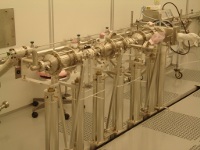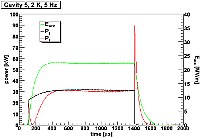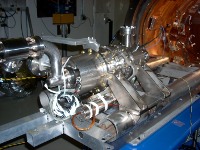 |
 |
|||||||||||||
|
|||||||||||||
|
|||||||||||||
|
The majority of NewsLine readers are scientists – most of you of the experimental kind. So be honest: how often during the last few weeks, when listening to carols, plucking the strings of your old guitar that you only get out during the holidays or cringing at a dissonant brass band, did you think about the physics and the maths of music? Go to the ILCT-MDB Horizontal Test Stand at Fermilab now and you can experience a perfect third harmonic: that of a string of cavities being tested and assembled into a cryomodule.
The 3.9-Gigahertz "third harmonic" cryomodule is an essential ingredient to the FLASH free-electron laser at DESY in Hamburg, Germany, and one of Fermilab's contributions to the TESLA Technology Collaboration TTC that planned and built FLASH as a test facility for the superconducting radiofrequency technology needed for the ILC. Within FLASH, it will sit in front of the regular 1.3-Gigahertz accelerating cryomodules and play an essential role in the sorting and squeezing of the electron bunches. Unlike the regular ones that are supposed to accelerate the particle bunches as efficiently as possible, this module actually makes the energy distribution within the bunch more linear, which reduces the longitudinal emittance, thus leading to the production of brighter laserlight for users at the other end. The third harmonic module consists of four superconducting cavities. Their design acceleration gradient is 14 Megavolts per metre, but after full tests of three cavities well before and one just before the holiday break, the team around Fermilab's Helen Edwards and Elvin Harms is proud to report that they all reached gradients over 20 Megavolts per metre – “well above the design gradient,” says Harms. With tests on the fourth one done, they can now all be assembled into one string, which will then be tested and assembled into a full cryomodule in the early weeks of the new year. In fact the first three cavities were assembled into a string over a three-day span ending on December 13. “Our goal is to ship the completed module to DESY in early 2009,” says Harms. The cavities needed for this module were manufactured at JLab and Fermilab in a series of a total of eight cavities, out of which six went through a series of vertical tests. They were then equipped with feedthroughs, couplers and other appendages, tuned and conditioned, welded into a helium vessel and tested in a horizontal test stand. When the team sees their first module off to DESY it is not all over though: they are already sharing their new knowledge and hope to participate in any way possible with the builders of similar systems for the European XFEL – the official start date of constructions of DESY’s new light source is today. -- Barbara Warmbein |
|||||||||||||
| © International Linear Collider |


